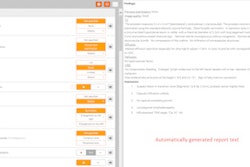
While structured reports can lower turnaround times and improve workflow, radiologists still need to adhere to important reporting criteria to provide the highest quality reports, Swiss researchers concluded during presentations at ECR 2014 earlier this month.
A team led by Dr. Tarek Laswad of the Institut de Radiologie de Sion, a multicenter group of private radiology clinics in the French-speaking part of Switzerland, shared their experiences from their 10-year shift from free-text reporting to standardized structured reports using templates and integrated key images.
Despite the transition to structured reporting, the group was still experiencing some mistakes with some of their reports. As a result, a research team sought to evaluate the quality of the group's radiology reporting, aiming to recognize the main quality criteria of radiology reporting, to identify and learn from their most common reporting mistakes, and improve their radiology reporting skills, Laswad said during a scientific presentation.
Quality criteria
Twelve radiologists participated in the study, which encompassed a total of 245 anonymized reports from radiography, ultrasound, mammography, CT, and MRI exams. Two radiologists independently reviewed each report for the presence of 32 quality criteria for radiology reporting. Of the 32, nine were considered major criteria and 23 were minor.
Quality criteria included the following:
- Title: Does it correspond to the study done? Was the side (left or right) specified?
- Indication: Is the problem clearly expressed? Is the text of the referral note reported? Are previous studies mentioned?
- Technique: Are important details of the exam included? Is the contrast (i.e., intravenous, oral, rectal) stated?
- Content of main body of the report: Were localization, size, measurements, and grading (mild, moderate, severe) information included?
- Conclusions: Was the clinician's main question answered? Was precision (size, side, grading) information included? Were comparisons made with previous studies? Was the conclusion clear and ordered by priority?
- Proposition: Were recommendations provided for follow-up of the lesion?
- Discordance: Was there discordance in the report between the discussion and the conclusion?
- Images: Were key images included in the report?
The independent observers analyzed each report, deducing one point for missing minor report criteria and three points for failing to include major criteria. A score of 100 was considered an excellent report with no points deducted. A score of 97-99 was considered to be good, while a report with a score of less than 97 was judged to be suboptimal.
Report scoring results are shown below:
- Excellent: 33%
- Good: 34%
- Suboptimal: 33%
The two radiologists with the lowest average scores tended to write nonstructured reports. "They estimate that reporting in radiology is an art of prose ... a liberty of expression," he said. "We had more problems with nonstructured reports in comparison with structured reports."
The study revealed the group's most frequent errors in reporting were: wrong study title, unclear indication, vague conclusion, and not answering the clinician's question. They also found a statistically significant difference in reporting quality between radiologists.
"Evaluation of colleagues' reports and consensus review help to improve our reporting skills," he said. "Also, the willingness of the radiologists [for quality control] is essential."
Based on the results, the researchers developed a check-list including the report criteria and distributed it to every radiologist for use during reporting.
An evolution
Laswad and colleagues also discussed the evolution of their group to structured reporting in an educational exhibit at ECR 2014. The 10-year process culminated in 2010 with the integration of standard templates in the group's new RIS/PACS. This development led to improved workflow and a significant reduction in turnaround time for radiology reports, according to the group.
"Many referring clinicians are now directly connected with our RIS/PACS by a teleradiology software system to consult the images and also to directly receive the reports of their patients," they wrote.
The 10 years of experience showed that structured reports have more advantages than disadvantages, according to the authors. The only disadvantages were experienced mainly by radiologists, and included cultural resistance to change by some radiologists, adaptation time (i.e. determining which anomalies go in which paragraph), and the fact that concentration on the template can distract from interpreting images, they noted.
Structured reports were also appreciated by the secretaries and are clearly preferred by the referring doctors over free-text reports, according to the researchers. In addition, the authors observed that the inclusion of key images in the report enables better communication with the referring doctors and also helps the radiologist's colleagues when they are interpreting the next follow-up study.
"By using a common language, thanks to structured standardized reporting, radiologists communicate better with the referring clinicians and also with each other," they wrote.



















